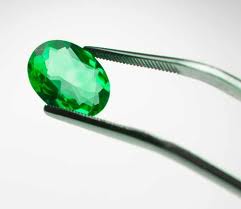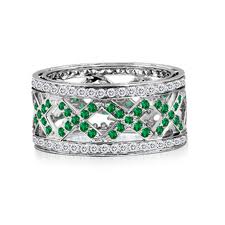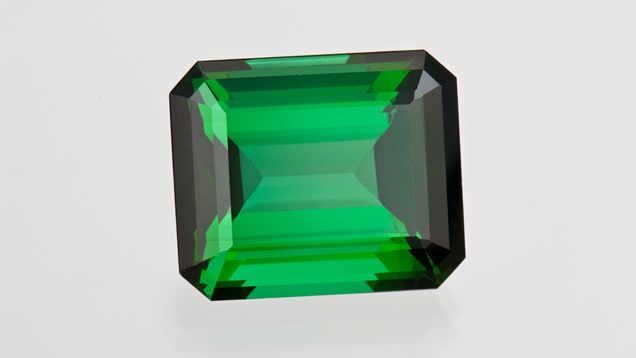One of our all time favorite movies is “Romancing the Stone” –the action, the adventure, the romance…and of course the EMERALD! Everyone in the film was after the huge stone called “El Corazon” (The Heart)– and for good reason too. 
Emerald is a rare and valuable gemstone, with its wonderful green color is unparalleled in the gem kingdom. Prized since ancient times, a fine emerald can be more expensive than a high quality diamond of the same carat weight.  Emeralds are green members of the popular beryl family of minerals. The green color occurs when pure, clear beryl contains either chromium or vanadium. The green crystals grow slowly within metamorphic rocks and are restricted in size by the rock, making large Emeralds rare and costly. Although this gemstone is relatively hard and durable, it must be protected from blows because the inclusions found within make it susceptible to breaking.
Emeralds are green members of the popular beryl family of minerals. The green color occurs when pure, clear beryl contains either chromium or vanadium. The green crystals grow slowly within metamorphic rocks and are restricted in size by the rock, making large Emeralds rare and costly. Although this gemstone is relatively hard and durable, it must be protected from blows because the inclusions found within make it susceptible to breaking.
Colombian emeralds are among the world’s most beautiful, with rich grass-green coloring that’s often kissed with a touch of blue. Quality emeralds are also found in India, South Africa, Afghanistan, Pakistan, Russia, Norway, Zimbabwe, and even recently in North Carolina!

The name Emerald is derived from the French “esmeraude” and the Greek root “smaragdos” which means ‘green gemstone’.
The history of emeralds can be traced back to antiquity. They were worn by royalty in Babylon and Egypt. Tools dating back to 1300 B.C., during the reign of Rameses II, have been found in emerald mines in Egypt. Queen Cleopatra’s emeralds were believed to originate from mines in Southern Egypt, near the Red Sea.
What about COLOR: hue, saturation and tone.
Emeralds occur in hues ranging from yellow-green to blue-green, with the primary hue being green. Yellow, blue, and red — the hues found adjacent to green on the color wheel — are the normal secondary hues found in emeralds. Only gems that are medium to dark in tone are considered emerald; light-toned gems are known instead by the species name green beryl. In addition, the hue of an emerald must be vivid and bright.
A fine emerald must possess not only a pure verdant green hue, but also a high degree of transparency to be considered a top gem.
Emeralds vary in color from light to deep green. The stone can, however, lose its color when heated strongly.
Unlike other beryls, emeralds usually contain inclusions and other flaws. These flaws are not looked on as negative aspects for emerald like they would be for other gemstones. These flaws are considered part of the character of the stone and are used to assure the purchaser of a natural stone.
Most emeralds are treated to enhance their appearance. Nearly all emeralds are treated with oils or epoxy resins to fill-in surface cracks, making the cracks less visible and improving transparency. Some coating oils are clear, some are tinted green to make the emeralds more vivid.
Care Tip:
Emeralds are brittle stones and care should be taken when wearing or cleaning them. It’s best to avoid cleaning emeralds with ultra-sonic devices, because that process can remove coatings.
Too Good To Be True…
Since Emerald is a rare and valuable gemstone, it has provided the incentive for developing synthetic emeralds. They are often referred to as “created”, as their chemical and gemological composition is the same as their natural counterparts.
The way synthetic emeralds are grown has changed, but they have been produced for many years. Some of the stones even have inclusions that make them look natural. True synthetic gems have the same chemical characteristics as their natural counterparts,
Even artificial emeralds often contain flaws, however, as the process of growing artificial emeralds mimics the way nature does it (slow crystal growth from a molten mix).
Clarity
Emerald tends to have numerous inclusions and surface breaking fissures. Unlike diamond, where the loupe magnification is used to grade clarity, emerald is graded by eye. So, if an emerald has no visible inclusions to the eye, it is considered flawless.
History and Folklore…
Traditionally, emeralds are worn to promote healing, love, contentment and traditionally thought to enhance the clairvoyance of their wearers.
There are many myths associated with the emerald. The stone was once believed to prevent epilepsy, stop bleeding, cure dysentery and fever, and protect the wearer from panic. Its magnificent green color was said to rest and relieve the eye. To the ancient Romans, emeralds were dedicated to the goddess Venus because the green emerald symbolized the reproductive forces of nature. Early Christians saw it as a symbol of the resurrection of Christ. In the Middle Ages, emeralds were believed to hold the power to foretell the future.
Some people believe that wearing an Emerald brings wisdom, growth, and patience. And as any couple in a long-term relationship would agree, all of these qualities are essential for a successful and lasting love. This may explain why a gift of Emerald for an anniversary — or anytime — is considered symbolic of love and fidelity.



